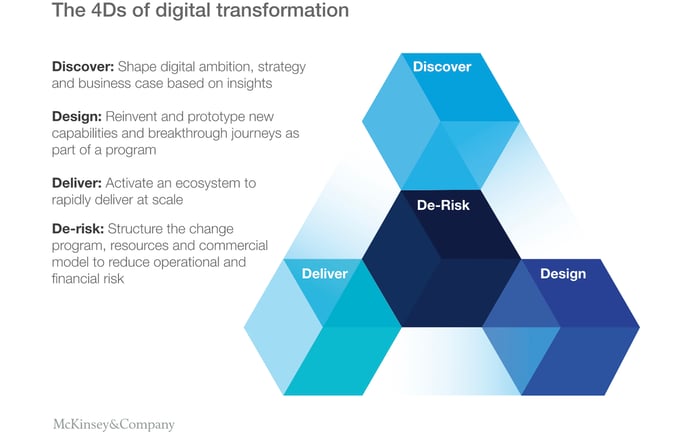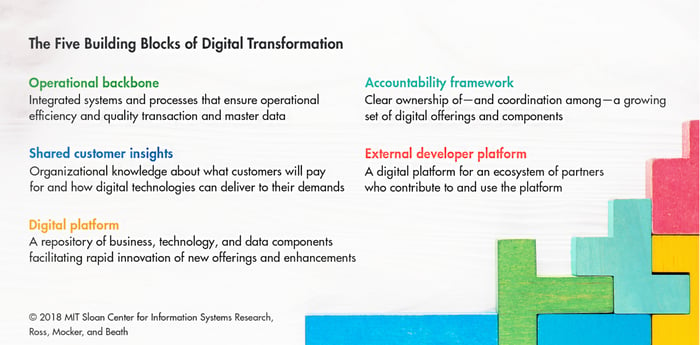What Is a Digital Transformation Framework?

To ensure such changes are successfully implemented at every level of the company, it helps to have a well-defined plan that everyone, from the leadership to the lower-level employees, can refer to and help execute. This is where a digital transformation framework comes in.
Let’s take a closer look at the digital transformation framework: what it is, its principles, and how it works. We’ll also consider examples of the various frameworks.
Digital transformation framework explained
A digital transformation framework is a system of rules an organization establishes to guide it through the transformation. It’s a step-by-step blueprint for managing change, which makes the complex DX process easier to handle. It defines the goals and draws a path to achieving them across a company. The framework can be the element that makes or breaks the digital transformation. That’s why it’s so important to understand it and learn how to implement it before embarking on the DX journey.
There are many different DX frameworks, many of which have been developed by consulting companies. Some are more straightforward and others more complex. Here are a few of the popular ones:
McKinsey’s DX framework has customer experience at its heart
McKinsey developed a DX framework called 4Ds. It’s based on the simple but important premise that each step of the process should keep the ultimate goal in mind: to increase the value the company provides to its customers. This framework places customer experience as the focal point which is definitely the way to go for a digital-first company. It also underscores how important it is to interconnect all the stages and not to fall short on any of them.

Source: McKinsey&Company The 4Ds of Digital Tranformation
According to McKinsey, “While this approach may seem self-evident, we find that most companies fall short in the execution.” Many invest heavily in the “Discover” stage but later, when “change exhaustion” sets in, the effort and the budget diminish.To mitigate this risk, it’s important to focus on quick wins that not only build momentum but also generate cost savings that can be reinvested in the next round of transformations.
MIT digital transformation framework
The MIT Sloan Center for Information Systems Research framework is based on years of academic research, solid data, and studies of international companies which successfully embraced digital transformation, such as LEGO and Toyota.

Source: MIT Management Sloan School 5 building blocks of digital transformation
This framework points out a mistake that many companies make: jumping head-first into digital transformation without first establishing the necessary foundation. They start with building a digital platform without first making sure they have the operational backbone and shared customer insights in place. Even the world’s best digital platform won’t make up for a lack of necessary systems and processes, and knowledge of customer needs.
The MIT researchers emphasize that digital transformation is a long process requiring resources and patience, and even the companies that do it successfully often don’t see the benefits right away.
Ionology digital transformation framework
The Ionology framework focuses on the leaders, defining them as the drivers of digital transformation who are able to bring the whole organisation to a new level. It demonstrates the importance of gathering data even before starting the process, assessing possibilities and risks, and creating measurable goals.
Key principles of digital transformation frameworks
As you can see, in the case of each framework, there are a few common stages that are critical successful digital transformation. At Netguru, we follow the following key steps while adapting to a company’s specific situation and seeking to maximize business value:
- Building a strong business case
- Prototype-based feasibility study
- Incremental solution delivery
- Go to market/internal communication strategy
- Scaling up: adoption, impact, results
How a digital transformation framework helps in IT projects
Since IT projects tend to be very complex, it helps to have a clear unifying objective keeping all the stakeholders on the same page as the project moves through different stages. This is what makes a digital transformation framework particularly useful in software development.
However, a framework provides general guidelines only. For the project to stay relevant and innovative, it might be necessary to change the objectives set by the framework as the project evolves. That’s why IT projects benefit from more agile management, where adaptive, incremental process complements traditional project management and embraces the fact that requirements evolve as a product develops.
Finally, the framework, when implemented for a strictly technological project, should be a helpful reminder that the IT product is not the goal in itself but a way to get to the goal – helping the company better serve its customers in the digital space.
How companies use digital transformation frameworks
Companies big and small have been using digital transformation frameworks for a number of years.
For Keller Williams, the real-estate franchise with the most agents in the world, digital transformation began when it decided to reposition itself as a tech company. Instead of relying on third-party tech solutions, Keller Williams decided to create its own proprietary software to gather data to empower agents and improve customer experience. That required a complete transformation into a fully digital company. Having its own software allows Keller Williams to be a technology independent company and always stay a step ahead of the competition.
A framework for change now, and in the future
Digital transformation is a continuous process. Even after going through it, you cannot say the job is over. New technology will keep changing the business landscape and outside forces will require companies to keep transforming to stay successful. That’s what makes the digital transformation framework such a useful tool: it guides you through DX and makes even the most daring change easier to manage. It can be used over and over and when change comes again, you will be ready.
At Netguru, we can help your company succeed at every stage of the digital transformation process. Learn more about our experience with DX and our services.





















